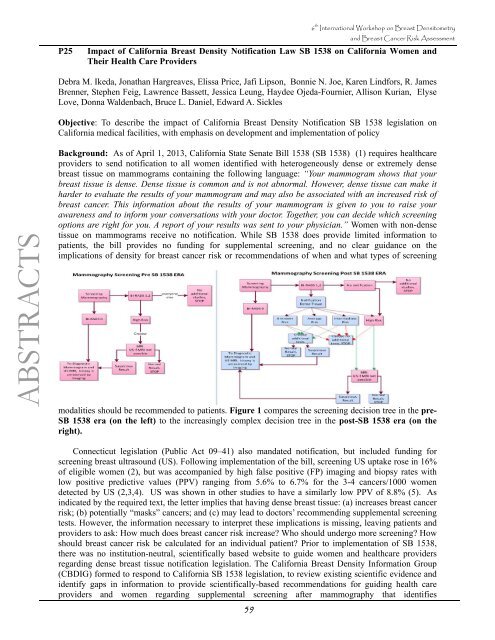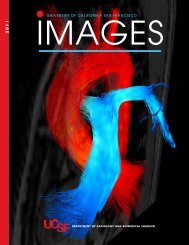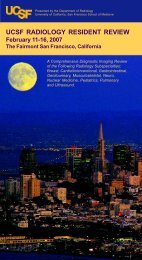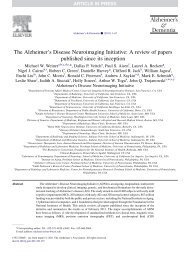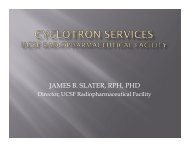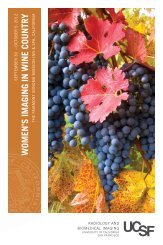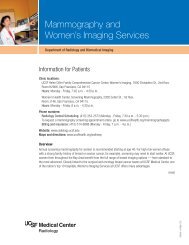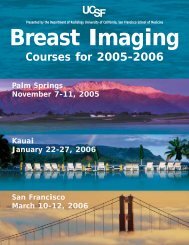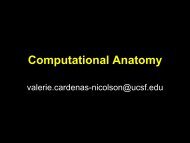6th International Workshop on Breast Densitometry and Breast ...
6th International Workshop on Breast Densitometry and Breast ...
6th International Workshop on Breast Densitometry and Breast ...
- No tags were found...
You also want an ePaper? Increase the reach of your titles
YUMPU automatically turns print PDFs into web optimized ePapers that Google loves.
P25<br />
6 th <str<strong>on</strong>g>Internati<strong>on</strong>al</str<strong>on</strong>g> <str<strong>on</strong>g>Workshop</str<strong>on</strong>g> <strong>on</strong> <strong>Breast</strong> <strong>Densitometry</strong><br />
<strong>and</strong> <strong>Breast</strong> Cancer Risk Assessment<br />
Impact of California <strong>Breast</strong> Density Notificati<strong>on</strong> Law SB 1538 <strong>on</strong> California Women <strong>and</strong><br />
Their Health Care Providers<br />
Debra M. Ikeda, J<strong>on</strong>athan Hargreaves, Elissa Price, Jafi Lips<strong>on</strong>, B<strong>on</strong>nie N. Joe, Karen Lindfors, R. James<br />
Brenner, Stephen Feig, Lawrence Bassett, Jessica Leung, Haydee Ojeda-Fournier, Allis<strong>on</strong> Kurian, Elyse<br />
Love, D<strong>on</strong>na Waldenbach, Bruce L. Daniel, Edward A. Sickles<br />
Objective: To describe the impact of California <strong>Breast</strong> Density Notificati<strong>on</strong> SB 1538 legislati<strong>on</strong> <strong>on</strong><br />
California medical facilities, with emphasis <strong>on</strong> development <strong>and</strong> implementati<strong>on</strong> of policy<br />
ABSTRACTS<br />
Background: As of April 1, 2013, California State Senate Bill 1538 (SB 1538) (1) requires healthcare<br />
providers to send notificati<strong>on</strong> to all women identified with heterogeneously dense or extremely dense<br />
breast tissue <strong>on</strong> mammograms c<strong>on</strong>taining the following language: “Your mammogram shows that your<br />
breast tissue is dense. Dense tissue is comm<strong>on</strong> <strong>and</strong> is not abnormal. However, dense tissue can make it<br />
harder to evaluate the results of your mammogram <strong>and</strong> may also be associated with an increased risk of<br />
breast cancer. This informati<strong>on</strong> about the results of your mammogram is given to you to raise your<br />
awareness <strong>and</strong> to inform your c<strong>on</strong>versati<strong>on</strong>s with your doctor. Together, you can decide which screening<br />
opti<strong>on</strong>s are right for you. A report of your results was sent to your physician.” Women with n<strong>on</strong>-dense<br />
tissue <strong>on</strong> mammograms receive no notificati<strong>on</strong>. While SB 1538 does provide limited informati<strong>on</strong> to<br />
patients, the bill provides no funding for supplemental screening, <strong>and</strong> no clear guidance <strong>on</strong> the<br />
implicati<strong>on</strong>s of density for breast cancer risk or recommendati<strong>on</strong>s of when <strong>and</strong> what types of screening<br />
modalities should be recommended to patients. Figure 1 compares the screening decisi<strong>on</strong> tree in the pre-<br />
SB 1538 era (<strong>on</strong> the left) to the increasingly complex decisi<strong>on</strong> tree in the post-SB 1538 era (<strong>on</strong> the<br />
right).<br />
C<strong>on</strong>necticut legislati<strong>on</strong> (Public Act 09–41) also m<strong>and</strong>ated notificati<strong>on</strong>, but included funding for<br />
screening breast ultrasound (US). Following implementati<strong>on</strong> of the bill, screening US uptake rose in 16%<br />
of eligible women (2), but was accompanied by high false positive (FP) imaging <strong>and</strong> biopsy rates with<br />
low positive predictive values (PPV) ranging from 5.6% to 6.7% for the 3-4 cancers/1000 women<br />
detected by US (2,3,4). US was shown in other studies to have a similarly low PPV of 8.8% (5). As<br />
indicated by the required text, the letter implies that having dense breast tissue: (a) increases breast cancer<br />
risk; (b) potentially “masks” cancers; <strong>and</strong> (c) may lead to doctors’ recommending supplemental screening<br />
tests. However, the informati<strong>on</strong> necessary to interpret these implicati<strong>on</strong>s is missing, leaving patients <strong>and</strong><br />
providers to ask: How much does breast cancer risk increase Who should undergo more screening How<br />
should breast cancer risk be calculated for an individual patient Prior to implementati<strong>on</strong> of SB 1538,<br />
there was no instituti<strong>on</strong>-neutral, scientifically based website to guide women <strong>and</strong> healthcare providers<br />
regarding dense breast tissue notificati<strong>on</strong> legislati<strong>on</strong>. The California <strong>Breast</strong> Density Informati<strong>on</strong> Group<br />
(CBDIG) formed to resp<strong>on</strong>d to California SB 1538 legislati<strong>on</strong>, to review existing scientific evidence <strong>and</strong><br />
identify gaps in informati<strong>on</strong> to provide scientifically-based recommendati<strong>on</strong>s for guiding health care<br />
providers <strong>and</strong> women regarding supplemental screening after mammography that identifies<br />
59


